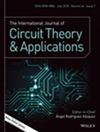双相开路故障下多相 PMSG 风力涡轮机的修正三阶滑模控制与自适应增益
IF 1.8
3区 工程技术
Q3 ENGINEERING, ELECTRICAL & ELECTRONIC
引用次数: 0
摘要
在向可再生能源过渡的过程中,风能生产系统(WEPS)越来越重要,其中永磁同步发电机(PMSG)因其高效率和高可靠性而被广泛采用。开发稳健的控制方法对于确保风能发电系统即使在不利条件下也能高效运行至关重要。本研究的重点是利用 5 相 PMSG 优化 WEPS 的控制策略,并解决双相开放故障 (DPOF) 情景带来的挑战。与基于超扭曲算法(STA)的传统二阶滑动模态控制(SOSMC)不同,所提出的方法通过将滑动面时间导数提升到三阶并用反正切函数修改 STA 的不连续项来提高性能,从而有望减少颤振效应。此外,自适应法则调整了改进后的 STA 增益,形成了自适应增益三阶滑模控制(AG-TOSMC),在风速波动、参数变化和 DPOF 等各种干扰情况下,其性能优于 SOSMC。与 SOSMC 相比,AG-TOSMC 通过降低波动率提高了有功和无功功率的质量。采用 AG-TOSMC 后,WEPS 的效率提高到 98.5%,超过了 SOSMC 的 93.5%。此外,DPOF 测试证实了五相 PMSG 能够在性能下降的情况下工作,为网络提供适当的电力,而不会产生明显的不利影响。数字模拟验证了所建议的 WEPS 及其控制的效率,表明 AG-TOSMC 性能优越。本文章由计算机程序翻译,如有差异,请以英文原文为准。
Modified third‐order sliding mode control with adaptive gains for a multiphase PMSG wind turbine under double‐phase open fault
Wind energy production systems (WEPS) are increasingly vital in the transition to renewable energy sources, with permanent magnetic synchronous generators (PMSG) being widely adopted due to their high efficiency and reliability. Developing robust control methods is essential to ensure that WEPS operate efficiently even under adverse conditions. This study focuses on optimizing control strategies for WEPS utilizing a 5‐phase PMSG and addresses challenges posed by double‐phase open fault (DPOF) scenarios. Unlike conventional second‐order sliding mode control (SOSMC) based on the super‐twisting algorithm (STA), the proposed method enhances performance by elevating the sliding surface time derivative degree to a third order and modifying the discontinuous term of STA with an arctangent function, promising to reduce chattering effects. Additionally, an adaptation law adjusts the improved STA gains, forming adaptive‐gain third‐order sliding mode control (AG‐TOSMC), which outperforms SOSMC under various disturbances such as wind speed fluctuations, parameter changes, and DPOF scenarios. The AG‐TOSMC enhances the quality of active and reactive power by reducing fluctuation ratios compared with the SOSMC. The efficiency of WEPS increases to 98.5% with AG‐TOSMC, surpassing the 93.5% achieved with SOSMC. Additionally, a DPOF test confirms the aptitude of the 5‐phase PMSG to work under degraded circumstances, supplying appropriate electrical power to the network without significant adverse effects. Numerical simulations validate the efficiency of the suggested WEPS and its control, demonstrating superior performance achieved with AG‐TOSMC.
求助全文
通过发布文献求助,成功后即可免费获取论文全文。
去求助
来源期刊

International Journal of Circuit Theory and Applications
工程技术-工程:电子与电气
CiteScore
3.60
自引率
34.80%
发文量
277
审稿时长
4.5 months
期刊介绍:
The scope of the Journal comprises all aspects of the theory and design of analog and digital circuits together with the application of the ideas and techniques of circuit theory in other fields of science and engineering. Examples of the areas covered include: Fundamental Circuit Theory together with its mathematical and computational aspects; Circuit modeling of devices; Synthesis and design of filters and active circuits; Neural networks; Nonlinear and chaotic circuits; Signal processing and VLSI; Distributed, switched and digital circuits; Power electronics; Solid state devices. Contributions to CAD and simulation are welcome.
 求助内容:
求助内容: 应助结果提醒方式:
应助结果提醒方式:


